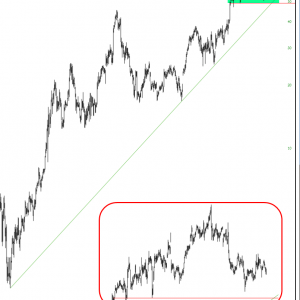Latest Posts
-
Finance 0
Gold Tumbles Below Key Technical Support As 5Y Yields Spike To Six-Year Highs
For the second day in a row, precious metals are being pounded as gold joins silver back below its 200-day moving-average… Knocking gold back to 3-week lows… All of which is odd given the chaos in the dollar… Two days of collapse in gold as the dollar goes nowhere… And Treasury yields are surging – with 5Y back at its highest since April 2011… ...On November 30, 2017 / By Kurt Osterberg -
Finance 0
All About Bitcoin
I joined Peggy Tuck Wednesday on Straight Talk Money. The topic of conversation? Bitcoin, of course. The cryptocurrency has gone parabolic, which raises the question: How high can it go? (Audio length 00:08:39) In the next segment, I reminisce about the last time I got wrapped up in a bubble… I was 10, and it was baseball cards. (Audio length 00:07:30)...On November 30, 2017 / By Kurt Osterberg -
Finance 0
Everyone, Even A Passive Vanguard Investor, Is A Factor Investor
Much has been made of Factor Investing, and even Vanguard is launching a suite of actively-managed factor ETFs. But even now, with Vanguard offering factor ETFs, there are many investors that only invest passively into an index fund, such as the SP 500 or EAFE index. These investors will cite the numerous studies showing that (on average) active management fails compared to an index fund (there are many studies that highlight this fact). No arguments with most of those studies and costs clearly matter, but what I would like to highlight in this article is the following: Even passive index investors are betting on factors. The idea behind th...On November 30, 2017 / By Kurt Osterberg -
Finance 0
Monetary Update For The Dollar
A dispassionate look at the quantities and flows of fiat dollars tells us much about the current state of the US economy, and therefore prospects for the dollar itself. This is a starting point for understanding the dynamics likely to affect the dollar’s purchasing power after the next credit-induced crisis, which are now beginning to clarify. That is the purpose of this article, which starts by updating the most recent developments in the quantity of fiat money (FMQ), the greatest of all monetary pictures. [i] Inflation of the fiat money quantity appears to be stalling, as the above graph attests. It has increased just under 3% over the...On November 30, 2017 / By Kurt Osterberg -
Finance 0
BEA Revises 3rd Quarter 2017 GDP Growth Upward To 3.30%
In their second estimate of the US GDP for the third quarter of 2017, the Bureau of Economic Analysis (BEA) reported that the US economy was growing at a +3.30% annual rate, up +0.32% from the previous estimate and up +0.24% from the prior quarter. The changes from the prior estimate reflect higher commercial fixed investment, higher inventory growth, more governmental spending and improved foreign trade. Consumer spending was essentially neutral. The BEA’s “bottom line” (their “Real Final Sales of Domestic Product”, which excludes inventories) increased to +2.50%, down -0.44% from the prior quarter. Real a...On November 30, 2017 / By Kurt Osterberg -
Finance 0
4 Compelling Low-Beta Tech Stocks In The Market Right Now
Currently, stock markets are flying high, courtesy of a favorable GDP growth rate, rising disposable income, an improving labor market with unemployment rate at a 16-year low, rise in economic activity post hurricanes and a low inflation rate. All these have considerably boosted consumer sentiment, which hit a 17-year high in November. Since the market is on an upward trajectory, investing in risky stocks will yield huge returns. However, one cannot ignore the various micro and macro factors that can lead to volatility when they come into play. Uncertainties That May Loom Large Market expectations for tax reform have increased as the GOP tax ...On November 30, 2017 / By Kurt Osterberg -
Finance 0
Chicago PMI Softens In November
The Chicago Business Barometer, also known as the Chicago Purchasing Manager’s Index, is similar to the national ISM Manufacturing indicator but at a regional level and is seen by many as an indicator of the larger US economy. It is a composite diffusion indicator, made up of production, new orders, order backlogs, employment, and supplier deliveries compiled through surveys. Values above 50.0 indicate expanding manufacturing activity. The latest report for Chicago PMI came in at 63.9, down from 66.2 last month. Investing.com forecast 63.0. Here is an excerpt from the press release: “Despite November’s fall, the MNI Chicago Busine...On November 30, 2017 / By Kurt Osterberg -
Finance 0
Cirrus-Ly?
The Dow is up hundreds of points to yet another lifetime high. Every asset is up (with the exception of gold, which of course sucks). So what to do? Show a short idea! Hey, come on, it’s at least worth a look… Cirrus Logic: ...On November 30, 2017 / By Kurt Osterberg -
Finance 0
Strong Corporate Profit Picture A Key Component In Today’s GDP Report
Included with today’s second estimate GDP report by the Bureau of Economic Analysis is the preliminary estimate for third quarter corporate profits. The corporate profit measure is reported in several different formats, i.e. with and without inventory valuation and capital consumption adjustments. As I noted in a June post, more information on the adjustments can be found can be found in this BEA Briefing Paper (PDF). The profit growth before tax and with the inventory valuation and capital consumption adjustments equaled 5.4% on a year over year basis. Without the adjustments, year over year profit growth equaled 10%. Importantly, ...On November 30, 2017 / By Kurt Osterberg -
Finance 0
Syndicated Mortgages Are No Safe Bet
Investments in syndicated mortgages and related securities have been heavily sold to yield-hungry savers and retirees the past few years, especially as our world-famous realty bubble has billowed in Canada. Advertising yields of 7 and 8%+– in a world where GICs and government bonds are paying 1-3%–many who can ill-afford the risk of loss have been sucked in like bugs to a zapper. The fact that these securities are eligible for RSPs/RIFs is also a big draw and serves to imbue a false of security or government endorsement of the products. As many are just starting to find out, these instruments are no safe bet. See Canada regulator ignored...On November 30, 2017 / By Kurt Osterberg
Top Posts
-
 The Importance for Individuals to Use Sustainable Chemicals
The Importance for Individuals to Use Sustainable Chemicals
-
 Small Businesses: Finding the Right Candidate for the Job
Small Businesses: Finding the Right Candidate for the Job
-
 How to Write the Perfect Thank You Letter After Your Job Interview
How to Write the Perfect Thank You Letter After Your Job Interview
-
 3 Best Large-Cap Blend Mutual Funds For Enticing Returns
3 Best Large-Cap Blend Mutual Funds For Enticing Returns
-
 China suspected in massive breach of federal personnel data
China suspected in massive breach of federal personnel data













